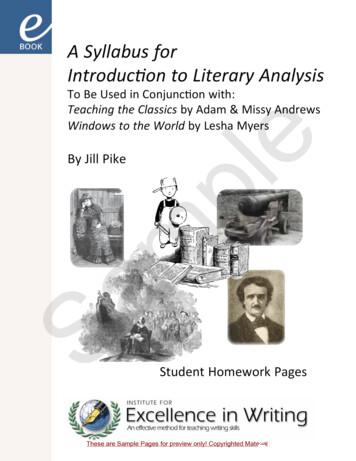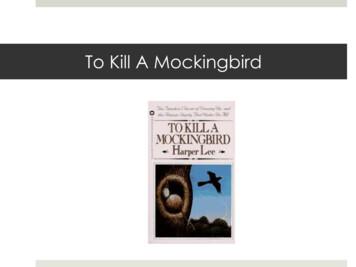To Kill A Mockingbird PowerPoint - Files.gabbart
To Kill a Mockingbird By Harper Lee
Setting Maycomb, Alabama (fictional city) 1933-1935 Although slavery has long been abolished, the Southerners in Maycomb continue to believe in white supremacy.
Themes Racial Prejudice Social Snobbery Morality Tolerance Patience Equality The Need for Compassion The Need for Conscience
Symbolism The Mockingbird: Symbolizes Everything That is Good and Harmless in This World The mockingbird only sings to please others and therefore it is considered a sin to shoot a mockingbird. They are considered harmless creatures who give joy with their song. The mockingbird image or symbol appears four times in the novel. Two characters in the novel symbolize the mockingbird: Tom Robinson & Boo Radley.
Jean Louis Finch – “Scout” The story’s narrator Although now an adult, Scout looks back at her childhood and tells of the momentous events and influential people of those years. Scout is six when the story begins. She is naturally curious about life.
Scout’s Character Traits Tomboy Impulsive Emotional Warm & Friendly Sensitive Adorable Gains in Maturity throughout the Novel
Atticus Finch Father of Scout and Jem A widower An attorney by profession Highly respected Good citizen Instills good values and morals in his children. His children call him “Atticus” Honest Typical southern gentleman Brave Courteous Soft-spoken
Jem Finch Scout’s older brother Looks up to his father Atticus Usually looks out for Scout Typical older brother at times Smart Compassionate Matures as the story progresses
Calpurnia The Finch’s black housekeeper Has watched the children since their mother’s death Has been a positive influence on the children.
Arthur “Boo” Radley An enigma An adult man, whose father has “sentenced” him to a lifetime confinement to their house because of some mischief he got into when he was a teenager. Has a reputation of being a lunatic Basically a harmless, well-meaning person Sometimes childlike in behavior Starving for love and affection Saves Jem and Scout from certain danger
Tom Robinson A young, harmless, innocent, hardworking black man Has a crippled left hand Married with three children. Works on a farm belonging to Mr. Link Deas, a white man Will be falsely accused of raping a white girl, Mayella Ewell
Dill A close friend of Jem and Scout Usually lives in Maycomb only during the summer (stays with a relative) Tells “big stories” Has been deprived of love and affection
Two Poor White Families: The Cunninghams Poor white family Hard-working Honest Proud Survive on very little Always pay back their debts – even if it is with hickory nuts, turnips, or holly. The Ewells Poor white trash Dirty Lazy Good-for-nothing Never done a day’s work Foul-mouthed Dishonest Immoral
The Black Community Simple Honest Clean Hard-working God fearing Proud Would never take anything with paying it back Respectful Had stronger character than most of the whites Oppressed Uneducated Discriminated against Talked about badly Deserve better than what is dished out to them by society
Language Sometimes the language of Scout will be that of her as a child; other times, she will be speaking in the voice of an adult Atticus uses formal speech Calpurnia uses “white language” in the Finch house and switches to “black jargon” when amidst blacks The Ewells use foul words and obscenities Jem, Scout, and Dill will use slang words, typical of their age Tom Robinson uses language typical of the southern black such as “suh” for “sir” and “chillun” for “children” Various derogatory terms for blacks will be used such as “nigger,” “darky,” “Negroes,” and “colored folk” – Lee uses such language to keep her novel naturally in sync with common language of the times
Tone Somber Serious Humorous (at times)
Harper Lee She was born in 1926 in Monroeville, Alabama (the fictional “Maycomb, Alabama”) Her father “Amasa” was a lawyer whom she deeply admired Her mother’s maiden name was “Finch” Her own childhood mirrors that of the character “Scout” In 1960 she published her only novel – “To Kill a Mockingbird” It received the Pulitzer Prize for Literature in 1961 Since 1960, “To Kill a Mockingbird” has never been out of print At age 81, she is alive and resides in New York She rarely makes public appearances or gives interviews
Life During the 1930s Race Relations Nine black teenagers are falsely charged with raping two white women in Scottsboro, Alabama; eight are convicted and sentenced to death The U.S. Supreme Court reverses their convictions because their constitutional rights had been violated The teens are tried for a second time, and are again found guilty The Supreme Court reverses the convictions again Eventually, four of the defendants are freed; the other five serve prison terms The last Scottsboro defendant was paroled in 1950 It was virtually impossible for a black to receive a fair trial
Life During the 1930s The Great Depression sweeps the nation – Many families do not even have money for basic needs such as food, clothing, and shelter. The per capita income for families in Alabama (and Oklahoma) is 125 - 250 a year Many southern blacks pick cotton for a living Franklin D. Roosevelt is President
Life During the 1930s Hitler is Chancellor of Germany He believes that Jews, African Americans, and other races are inferior to Anglo-Saxons. In 1936, Jesse Owens, a black American athlete, traveled to Germany to participate in the Summer Olympics. Owens’ biggest competitor in the long jump was a German named Luz Long. Despite racial tensions, the two became good friends. Jesse Owens won the gold medal and Long won the silver. Long was later killed during World War II, and Jesse Owens traveled back to Germany to pay his respects when the war was over.
Legal Segregation in Alabama, 1923-1940 No white female nurses in hospitals that treat black men Separate passenger cars for whites and blacks Separate waiting rooms for whites and blacks Separation of white and black convicts Separate schools No interracial marriages Segregated water fountains Segregated theatres
Morphine: A Southern Lady’s Drug 1930s Typical Morphine Addict: White female Middle-aged or older Widowed Homebound Lives in the south Property owner Began using morphine for medical reasons (pain relief) In “To Kill a Mockingbird,” the Finch children will become acquainted with a morphine addict named Mrs. Dubose. Although only a fictitious character, she personifies the American morphine addict of the late nineteenth and early twentieth centuries.
This PowerPoint was created by Mrs. Ward especially for the 4th Hour English I students at Warner High School. I hope you enjoy the book!
This powerpoint was kindly donated to www.worldofteaching.com http://www.worldofteaching.com is home to over a thousand powerpoints submitted by teachers. This is a completely free site and requires no registration. Please visit and I hope it will help in your teaching.
The mockingbird only sings to please others and therefore it is considered a sin to shoot a mockingbird. They are considered harmless creatures who give joy with their song. The mockingbird image or symbol appears four times in the novel. Two characters in the novel symbolize the mockingbird: Tom Robinson & Boo Radley .
Begin reading To Kill a Mockingbird. Begin list of vocabulary, characters, and places. WW 6 Literature Study: To Kill a Mockingbird Part 1 Vocabulary Quiz 10 WW 7 Literature Study: To Kill a Mockingbird Part 2 Repeat Exercise 4: Plot Analysis. 50 WW 8 Literature Study: To Kill a Mockingbird Part 3
‘To Kill a Mockingbird’ was written by Harper Lee. It is a very famous American novel. ‘To Kill a Mockingbird’ is about a girl called Scout Finch. She lives in America. The novel is set in the 1930s in the U.S.A. One of the most important themes in ‘To Kill a Mockingbird’ is rac
To Kill a Mockingbird? "Mockingbirds don't do one thing but make music for us to enjoy. They don't eat up people's gardens, don't nest in corncribs, they don't do one thing but sing their hearts out for us. That's why it's a sin to kill a mockingbird." — Miss Maudie Think of "killing a mockingbird" like being prejudiced or
Lee, Harper—To Kill a Mockingbird 1960 TO KILL A MOCKINGBIRD by Harper Lee DEDICATION for Mr. Lee and Alice in consideration of Love & Affection Lawyers, I suppose, were children once. Charles Lamb PART ONE 1 When he was nearly thirteen, my brother Jem got his arm badly broken at the elbow. When it healed, and Jem’s fears of never being
classic, To Kill a Mockingbird. SEE is a non-profit teaching organization based in Milford, Connecticut, with the mission to provide learning experiences that advance ethics and character. The following To Kill a Mockingbird (TKAM) unit is designed to be taught to students in middle or high school.
To Kill a Mockingbird By Harper Lee Chapters 1-2 Before you read the chapter: The protagonist in most novels features the main character or “good guy”. The main character of To Kill a Mockingbird is Scout Finch, an enterprising young girl living in Maycomb, Alabama during the 1930s. Think back
To Kill A Mockingbird novel- each student has their own copy Copies/PDFs of two articles- “Ain’t I A Woman”, “Equal Rights for Women” Various graphic organizers available through Canvas Movie of To Kill A Mockingbird Websites pertaining to cou
The Academic Phrasebank is a general resource for academic writers. It aims to provide the phraseological ‘nuts and bolts’ of academic writing organised according to the main sections of a research paper or dissertation. Other phrases are listed under the more general communicativ e functions of academic writing. The resource was designed primarily for academic and scientific writers who .























